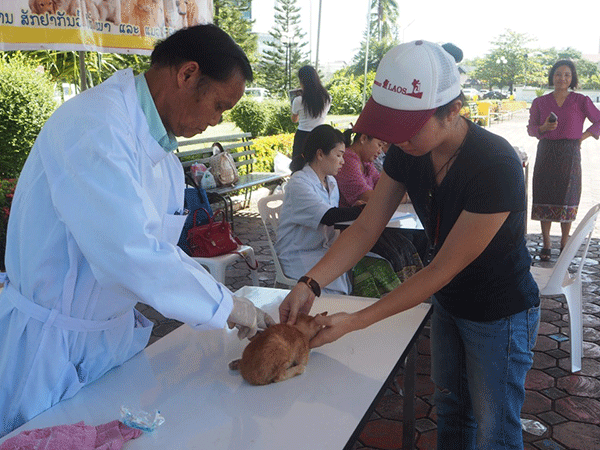VIENTIANE, Laos: Rabies a significant threat to Asian livestock production, regional cooperation needed to eradicate the disease
While rabies continues to present a threat to human health, in many parts of Asia livestock are also at risk of exposure and greater efforts are needed to eradicate the disease, the Food and Agriculture Organization of the United Nations (FAO) said yesterday.
In Asia, as in most parts of the world, dogs are the main source of rabies in humans and livestock. In some areas, wild carnivores also play a role in rabies transmission. As most livestock production in Asia originates in smallholder ‘backyard’ farms, these animals are at risk of encountering rabid canines.
Rabies remains hard to eradicate in many countries due to the lack of functioning dog vaccination programmes or due to the use of poor quality vaccines. Lack of awareness and political commitment to act are also issues.
Very few countries in Asia are rabies-free
 |
In some parts of Asia, the population of dogs continues to grow. In Bhutan, a country of less than 750,000 inhabitants, there are large numbers of free roaming dogs in towns and in the countryside. In Thailand, particularly in urban areas, stray dogs are also a common site. In both cases, cultural norms influence the relationship between dogs and humans.
THIS SPACE BELOW IS RESERVE FOR YOUR ADVERTISEMENT –

“Very few countries in Asia can claim to be rabies-free,” said Katinka de Balogh, FAO Senior Animal Production Health Officer. “Mass vaccination of canine populations is the best approach, but animal health authorities need to ensure they have procured good quality rabies vaccines. The use of a poor quality and less effective vaccine, in the long-run, is poor value for money as it will not control rabies effectively,” she added.
In one 10-year study of the economic impact of rabies in Viet Nam, a country deemed typical of most Asian countries’ experience with rabies, the associated costs in post-exposure treatments of people receiving a course of vaccinations after being bitten were in excess of USD 700 million. It found prevention measures much more cost effective, as the average cost of mass-vaccination of dogs is less than USD 2 per animal region-wide.
THIS SPACE BELOW IS RESERVE FOR YOUR ADVERTISEMENT –

However, while vaccination of domestic animals, like pets, is straightforward, programmes to vaccinate large numbers of free-roaming/street dogs is not. Teams of trained dog-catchers and vaccinators are needed to track and carefully catch and vaccinate the animals as there is the inherent risk of being bitten.
Veterinary experts gather in Bangkok to plan regional course of action
In order to tackle the problem of rabies in animals and in humans, scientists and practitioners from Asia, Europe and the Americas are meeting to discuss ways to put rabies eradication theory into practice in the Asia-Pacific region.
While many different approaches are being studied and discussed, one of the more pressing concerns is to get countries talking to each other on ways to eliminate the disease, and to help protect their livestock and the livelihoods of their smallholder farmers.
THIS SPACE BELOW IS RESERVE FOR YOUR ADVERTISEMENT –

“Like many transmittable diseases, animals infected with rabies can easily cross international borders, and this is often facilitated through human behaviour,” said de Balogh. “That’s why greater cooperation and collaboration is needed between countries in this region. It’s in everyone’s best interests.”
FAO is co-supporting the meeting organized by the International Alliance for Biological Standardization and Thailand’s National Vaccine Institute. Other supporting partners include the World Organisation for Animal Health (OIE), World Health Organization (WHO) and the Global Alliance for Rabies Control (GARC). The two-day meeting is hosted by the Department of Disease Control, Ministry of Public Health, Royal Thai Government.
Further awareness of rabies prevention techniques will be on display this weekend across the region. On 28 September, #WorldRabiesDay, FAO will join with OIE and WHO to promote the goal of rabies elimination. #EndRabiesTogether
Source: http://www.fao.org/asiapacific/news/detail-events/en/c/1234713/
By Phetphoxay Sengpaseuth
(Latest Update September 27, 2019)
TRIVIA:
Description
Laos is a Southeast Asian country traversed by the Mekong River and known for mountainous terrain, French colonial architecture, hill tribe settlements and Buddhist monasteries. Vientiane, the capital, is the site of the That Luang monument, where a reliquary reportedly houses the Buddha’s breastbone, plus the Patuxai war memorial and Talat Sao (Morning Market), a complex jammed with food, clothes and craft stalls.
THIS SPACE BELOW IS RESERVE FOR YOUR ADVERTISEMENT –


All photographs, news, editorials, opinions, information, data, others have been taken from the Internet..aseanews.net









